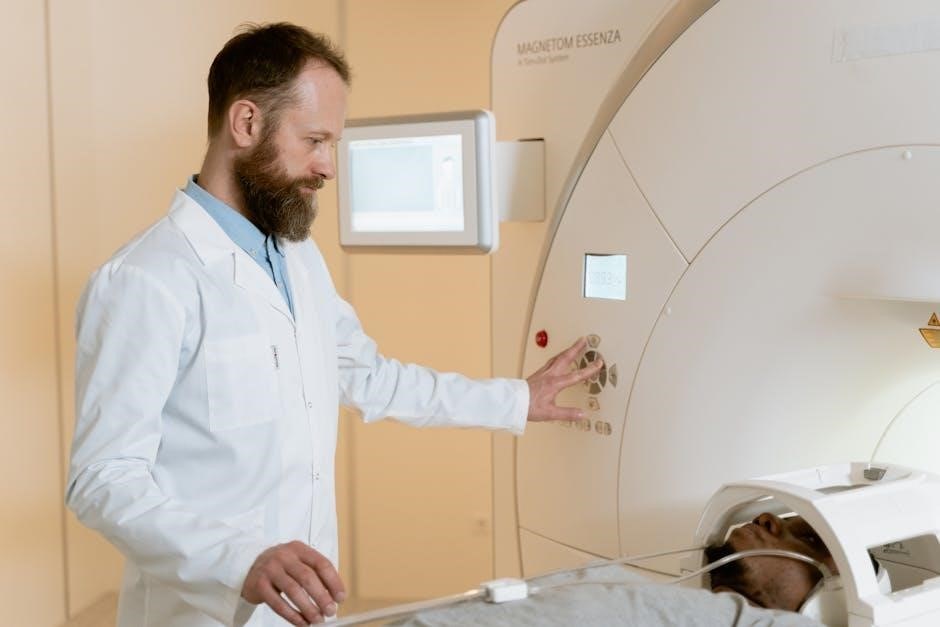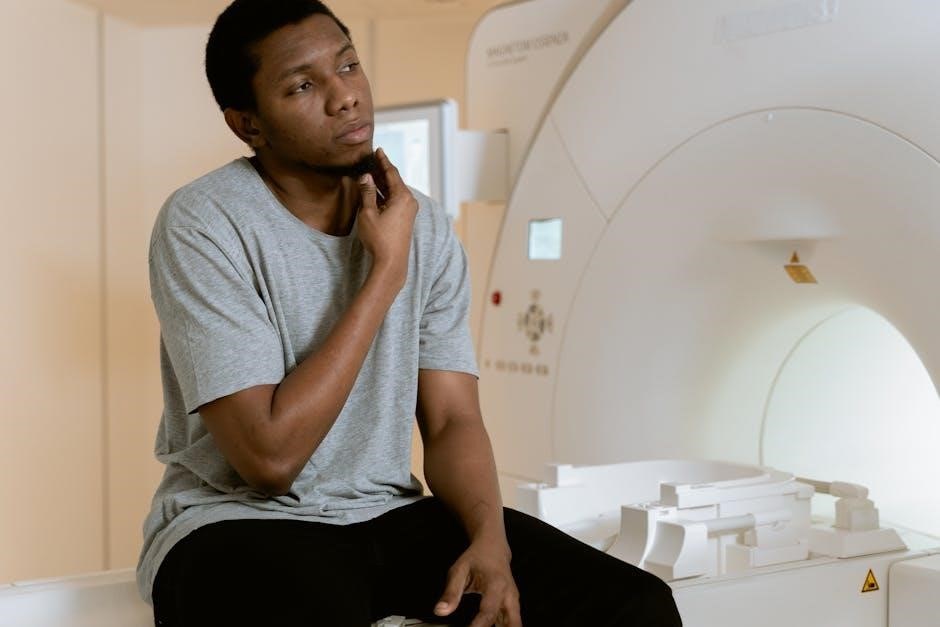Are you looking for a free PDF of “Physical Examination and Health Assessment, 9th Edition”?
This widely used resource, authored by Carolyn Jarvis, is a comprehensive guide to health assessment.
While a free PDF may be challenging to find due to copyright, explore online libraries.
Overview of Jarvis’s Physical Examination and Health Assessment, 9th Edition
Jarvis’s “Physical Examination and Health Assessment, 9th Edition” stands as a cornerstone resource in nursing education, widely recognized for its comprehensive and accessible approach to health assessment across the lifespan.
This edition, authored by Carolyn Jarvis and Ann Eckhardt, continues the tradition of providing a tightly integrated learning package centered around a clear, logical, and holistic methodology.
It’s designed to equip students and practitioners with the knowledge and skills necessary to conduct thorough and accurate physical examinations and health assessments.
The text utilizes vivid illustrations, step-by-step guidance, and evidence-based content to ensure a complete understanding of the subject matter.
The 9th edition maintains its reputation as an authoritative and easily implemented learning solution, making it an invaluable tool for both academic study and clinical practice.
The book adopts an easy-to-follow approach coupled with unmatched learning support.
The text consistently emphasizes the importance of cultural sensitivity and patient-centered care, reflecting the evolving landscape of healthcare.
Moreover, the integration of technology and online resources further enhances the learning experience, providing students with interactive tools and supplementary materials to reinforce their understanding.
Overall, Jarvis’s 9th edition serves as a crucial resource for mastering physical examination and health assessment skills.
Key Features of the 9th Edition
The 9th Edition of “Physical Examination and Health Assessment” by Jarvis and Eckhardt boasts several key features designed to enhance the learning experience and improve clinical practice.
A primary focus is the integration of evidence-based practice, ensuring that assessment techniques and guidelines are aligned with the latest research findings.
The edition includes updated content reflecting current healthcare trends, such as increased focus on social determinants of health.
Vivid, detailed illustrations provide visual support for understanding anatomical structures and examination techniques.
Step-by-step guidance is offered for performing various assessment procedures, making the learning process more practical and accessible.
Cultural considerations are emphasized throughout the text, promoting culturally competent care and sensitivity to diverse patient populations.
The inclusion of critical thinking exercises encourages students to apply their knowledge to real-world scenarios.
Online resources, such as videos and interactive modules, supplement the textbook content, offering a multi-modal learning approach.
Case studies and patient narratives are incorporated to provide context and illustrate the application of assessment skills in clinical settings.
The 9th edition aims to provide students with the tools necessary to master physical examination and health assessment skills in both the laboratory and clinical practice.
It also includes updated information on family violence, human trafficking, and substance use assessment.
Content and Approach
“Physical Examination and Health Assessment,” 9th Edition, employs a clear, logical, and holistic approach, focusing on physical examination and health assessment across the patient lifespan.
The content is meticulously organized, starting with foundational concepts and progressing to more complex assessment techniques.
Each chapter provides a comprehensive overview of a specific body system or assessment area, incorporating relevant anatomy, physiology, and pathophysiology.
The text integrates various assessment techniques, including inspection, palpation, percussion, and auscultation, providing step-by-step guidance on how to perform each technique effectively.
Special attention is given to differentiating normal findings from abnormal findings, enabling students to develop critical thinking skills and make informed clinical judgments.
The text also emphasizes the importance of obtaining a thorough health history, including subjective data from the patient and objective data from the physical examination.
Throughout the book, cultural considerations are integrated to promote culturally competent care and sensitivity to diverse patient populations.
The content is presented in a user-friendly format with clear headings, subheadings, and bulleted lists, making it easy for students to navigate and understand.
Numerous tables, charts, and diagrams are included to summarize key information and enhance visual learning.
The overall approach is designed to provide students with a solid foundation in physical examination and health assessment, preparing them for success in clinical practice;
The book also contains information and resources for the diagnosis of various diseases and conditions;
Evidence-Based Assessment
The 9th edition of “Physical Examination and Health Assessment” places a strong emphasis on evidence-based practice, ensuring that assessment techniques and clinical decision-making are grounded in the latest research findings.
The text incorporates numerous evidence-based guidelines and recommendations, providing students with the most current and reliable information available.
Each chapter includes dedicated sections that highlight the evidence supporting specific assessment techniques, helping students understand the rationale behind each practice.
The authors critically evaluate the research literature, presenting a balanced view of the strengths and limitations of different assessment approaches.
Students are encouraged to develop their critical thinking skills by evaluating the evidence and applying it to real-world clinical scenarios.
The text also includes examples of how evidence-based practice can improve patient outcomes and reduce healthcare costs.
By integrating evidence-based principles throughout the book, the authors aim to promote a culture of inquiry and lifelong learning among healthcare professionals.
The focus on evidence-based assessment ensures that students are equipped with the knowledge and skills necessary to provide safe, effective, and patient-centered care.
Furthermore, the text encourages students to question traditional practices and seek out new evidence to inform their clinical decision-making.
The book also provides resources for locating and evaluating research evidence, empowering students to become active participants in the evidence-based practice movement.
This approach helps bridge the gap between research and practice, promoting the use of best practices in healthcare settings.
The content is designed to foster a commitment to continuous quality improvement and the pursuit of excellence in patient care.
Cultural Assessment

The 9th edition of “Physical Examination and Health Assessment” underscores the importance of cultural competence in healthcare.
It provides students with the knowledge and skills necessary to conduct culturally sensitive and appropriate health assessments.
The text explores the influence of culture on health beliefs, practices, and behaviors, emphasizing the need to tailor assessment techniques to meet the unique needs of diverse patient populations.
The book includes detailed discussions of various cultural groups, highlighting their specific health risks, communication styles, and preferences for healthcare.
Students learn how to avoid cultural stereotypes and biases, promoting respectful and patient-centered care.
The text also provides guidance on working with interpreters and cultural brokers to ensure effective communication and understanding.
Case studies and examples illustrate the challenges and opportunities of providing culturally competent care in diverse healthcare settings.
The authors emphasize the importance of self-awareness, encouraging students to reflect on their own cultural values and beliefs and how these may impact their interactions with patients.
The content promotes the development of cultural humility, recognizing that cultural competence is an ongoing process of learning and self-reflection.
By integrating cultural considerations throughout the book, the authors aim to prepare students to provide equitable and effective care to all patients, regardless of their cultural background.
The text also includes resources for learning more about specific cultural groups and accessing culturally appropriate healthcare services.
This comprehensive approach to cultural assessment ensures that students are well-equipped to meet the challenges of a diverse and ever-changing healthcare landscape.

Health History
In “Physical Examination and Health Assessment, 9th Edition,” the section on health history emphasizes its crucial role in comprehensive patient care.
It provides a structured approach to gathering subjective data from patients, forming the foundation for accurate diagnoses and effective treatment plans.
The text details the components of a complete health history, including biographical data, chief complaint, present health status, past health history, family history, review of systems, and functional assessment.
It offers practical guidance on interviewing techniques, emphasizing active listening, empathy, and effective communication skills.
The book explores the importance of establishing rapport with patients to encourage open and honest communication.
It also addresses strategies for interviewing patients with diverse cultural backgrounds, language barriers, or cognitive impairments.
Specific considerations for obtaining health histories from infants, children, adolescents, and older adults are also included.
The text provides examples of open-ended and closed-ended questions to elicit relevant information from patients.
It also emphasizes the importance of documenting the health history accurately and concisely.
The authors highlight the significance of identifying risk factors and health promotion opportunities during the health history assessment.
Case studies and examples illustrate how to apply the principles of health history taking in real-world clinical settings.
The content reinforces the idea that the health history is a dynamic and ongoing process, requiring continuous updates and revisions as new information becomes available.
By mastering the skills of health history taking, students can gain valuable insights into patients’ health status and develop individualized care plans that promote optimal outcomes.
Assessment Techniques and Safety
The “Physical Examination and Health Assessment, 9th Edition” meticulously details essential assessment techniques while emphasizing safety protocols.
It thoroughly explains the four cardinal techniques: inspection, palpation, percussion, and auscultation, providing step-by-step guidance on their proper application.
Inspection involves careful observation of the patient’s body, noting any abnormalities or deviations from the norm.
Palpation uses the sense of touch to assess texture, temperature, moisture, organ location and size, swelling, vibration, and pulsations.
Percussion involves tapping the body to assess underlying structures, producing sounds that vary depending on tissue density.
Auscultation utilizes a stethoscope to listen to sounds produced by the body, such as heart, lung, and bowel sounds.
The textbook emphasizes the importance of using the correct equipment and techniques to ensure accurate and reliable findings.
It also stresses the need for maintaining a safe and comfortable environment for both the patient and the examiner.
Safety precautions, such as hand hygiene, proper use of personal protective equipment (PPE), and sharps disposal, are thoroughly discussed.
The text highlights the importance of respecting patient privacy and maintaining confidentiality throughout the assessment process.
It also addresses potential risks associated with certain assessment techniques, such as infection control and latex allergies.
The book provides guidance on adapting assessment techniques for patients with specific conditions or limitations.
It includes information on positioning patients appropriately for different examinations.
Furthermore, the text covers how to modify techniques for pediatric, geriatric, and pregnant patients.
The content underscores the importance of critical thinking and clinical judgment in interpreting assessment findings.
By adhering to established safety guidelines and mastering assessment techniques, students can confidently perform physical examinations and contribute to accurate diagnoses.

General Survey and Measurement

The “Physical Examination and Health Assessment, 9th Edition” dedicates a section to the general survey and measurement, emphasizing their crucial role in forming an initial impression of the patient’s overall health status.
The general survey encompasses a comprehensive observation of the patient’s physical appearance, body structure, mobility, and behavior.
It begins the moment the examiner encounters the patient and continues throughout the entire assessment process.
Key aspects of physical appearance include age, sex, level of consciousness, skin color, and facial features.
Body structure assessment involves evaluating stature, nutrition, symmetry, posture, and body build.
Mobility is assessed by observing gait, range of motion, and the presence of any assistive devices.
Behavioral observations include facial expressions, mood, speech, dress, and personal hygiene.
Measurements, including height, weight, waist circumference, and body mass index (BMI), provide objective data about the patient’s physical dimensions and nutritional status.
Accurate height and weight measurements are essential for calculating BMI, which helps assess weight-related health risks.
Waist circumference is an indicator of abdominal fat and is associated with an increased risk of cardiovascular disease and type 2 diabetes.
The textbook provides detailed instructions on performing these measurements accurately and consistently.
It emphasizes the importance of using standardized techniques and calibrated equipment.
The text also highlights the significance of documenting the general survey and measurement findings clearly and concisely.
These initial observations and measurements serve as a baseline for further assessment and help identify potential health concerns.
The general survey and measurement section underscores the importance of integrating subjective and objective data to develop a holistic understanding of the patient’s health status.
Vital Signs Assessment
In “Physical Examination and Health Assessment, 9th Edition,” the vital signs assessment is presented as a cornerstone of patient evaluation, offering critical insights into the body’s physiological status.
This section extensively covers the measurement and interpretation of temperature, pulse, respiration, and blood pressure.
Temperature assessment includes various methods, such as oral, tympanic, axillary, and rectal, with considerations for accuracy and patient comfort.
Pulse assessment involves evaluating rate, rhythm, force, and elasticity, providing information about cardiovascular function.
Respiration assessment focuses on rate, rhythm, depth, and effort, reflecting respiratory health.
Blood pressure measurement is detailed, emphasizing proper technique, cuff size, and patient positioning to ensure accurate readings.
The text also addresses common errors in blood pressure measurement and strategies to avoid them.
Furthermore, the chapter discusses the significance of oxygen saturation as an additional vital sign, particularly in assessing respiratory conditions.
Normal ranges for vital signs are clearly defined, with variations across age groups and physiological states highlighted.
Factors that can influence vital signs, such as exercise, stress, medications, and underlying medical conditions, are thoroughly explored.
The importance of documenting vital signs accurately and promptly is emphasized, as these measurements provide a baseline for monitoring patient progress and detecting changes in health status.
Clinical scenarios are presented to illustrate how vital signs can be used to assess and manage various medical conditions.
The text also emphasizes the importance of integrating vital signs data with other assessment findings to develop a comprehensive understanding of the patient’s overall health.
The vital signs assessment chapter underscores the need for healthcare professionals to possess a strong foundation in these fundamental skills to provide safe and effective patient care.
Pain Assessment
The “Physical Examination and Health Assessment, 9th Edition” dedicates a significant portion to pain assessment, recognizing it as a subjective and multidimensional experience.
The chapter emphasizes the importance of a comprehensive pain assessment to effectively manage and alleviate patient suffering.
It highlights the use of various pain assessment tools, including numeric rating scales, visual analog scales, and verbal descriptor scales, to quantify pain intensity.
For patients unable to communicate verbally, observational tools like the FLACC scale are discussed.
The text details the PQRST mnemonic (Provocation/Palliation, Quality, Region/Radiation, Severity, Timing) as a framework for gathering detailed information about the patient’s pain experience.
It stresses the importance of assessing pain location, characteristics (e.g., sharp, dull, throbbing), onset, duration, and aggravating/alleviating factors.
The influence of psychological, emotional, and sociocultural factors on pain perception is thoroughly explored.
The chapter distinguishes between acute and chronic pain, discussing their different etiologies and management strategies.
It addresses common misconceptions about pain and emphasizes the importance of believing the patient’s self-report of pain.
Pharmacological and non-pharmacological approaches to pain management are discussed, with a focus on individualized treatment plans.
The text also covers the assessment of pain in special populations, such as infants, children, older adults, and patients with cognitive impairments.
The role of the healthcare professional in advocating for effective pain management is highlighted.
The chapter underscores the importance of reassessing pain regularly to evaluate the effectiveness of interventions.
It also emphasizes the need for a collaborative approach to pain management, involving the patient, family, and healthcare team.
The pain assessment chapter equips healthcare professionals with the knowledge and skills necessary to provide compassionate and effective pain management.
Availability and Formats (PDF, etc.)
Nutrition Assessment
The “Physical Examination and Health Assessment, 9th Edition” dedicates a comprehensive chapter to nutrition assessment, recognizing its crucial role in overall health and well-being.
The chapter emphasizes a holistic approach, considering various factors that influence nutritional status.
It covers methods for collecting a thorough dietary history, including 24-hour recalls, food frequency questionnaires, and food diaries.
The importance of assessing cultural and socioeconomic factors that may impact food choices and access is highlighted.
The text details techniques for performing anthropometric measurements, such as height, weight, body mass index (BMI), and waist circumference, to evaluate body composition and identify nutritional risks.
It explains how to interpret these measurements in the context of age, gender, and ethnicity.
The chapter discusses the significance of biochemical data, including serum albumin, prealbumin, and hemoglobin levels, in assessing protein status and identifying malnutrition.
Clinical signs of nutritional deficiencies, such as hair loss, skin lesions, and oral changes, are described in detail, providing visual cues for assessment.
The text addresses the nutritional needs of different life stages, including infancy, childhood, adolescence, pregnancy, lactation, and older adulthood.
It discusses common nutritional problems, such as obesity, malnutrition, eating disorders, and food allergies.
The chapter emphasizes the importance of nutrition education and counseling in promoting healthy eating habits.
It highlights the role of the healthcare professional in identifying individuals at risk for malnutrition and developing appropriate intervention strategies.
The use of standardized nutrition screening tools, such as the Mini Nutritional Assessment (MNA), is discussed.
The chapter also covers the nutritional assessment of patients with specific medical conditions, such as diabetes, heart disease, and cancer.
It underscores the importance of interdisciplinary collaboration in providing comprehensive nutrition care.
The nutrition assessment chapter equips healthcare professionals with the knowledge and skills necessary to identify and address nutritional imbalances, promoting optimal health outcomes.


